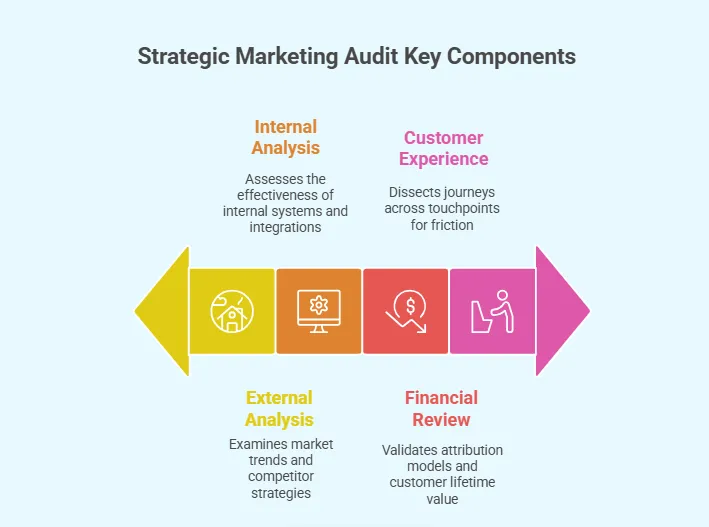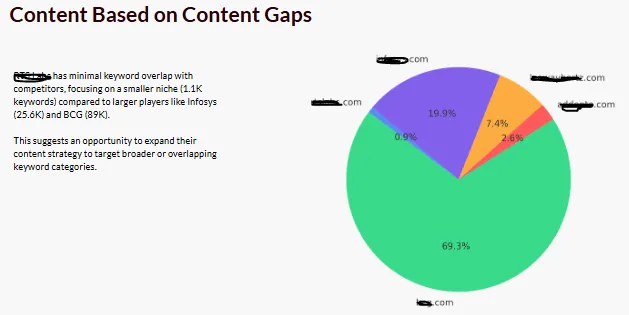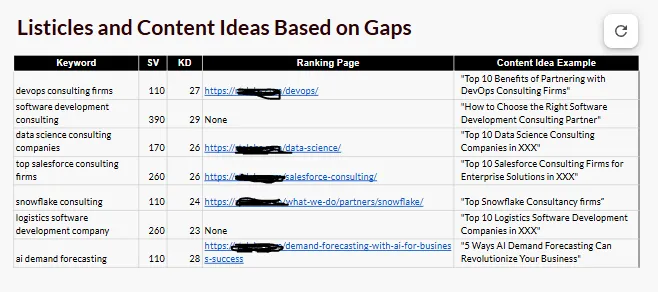






















You manage multi-million-dollar marketing budgets across paid search, social media platforms, programmatic, and connected TV. Yet most enterprise teams like yours admit they can’t trace the majority of spend back to ROI.
Only 25% of marketing leaders report high visibility into ROI.
That visibility gap makes it harder to compare customer acquisition cost with customer lifetime value, evaluate campaign performance across channels, and align spend with long-term marketing goals.
A strategic marketing audit helps you take that control. It connects marketing activities to measurable outcomes, strengthens competitive analysis, and gives you sharper insights into customer journeys and campaign efficiency.
In this blog, we’ll cover:
P.S. Audits that only generate static reports won’t move your performance forward. Fieldtrip integrates strategy, creative, media, and measurement into one system, so every audit insight ties back to ROI and enterprise growth. Let’s talk!
A strategic marketing audit is a complete performance review that links every marketing activity to ROI, CAC, and CLV.
It exposes inefficiencies across channels, systems, and budgets while highlighting opportunities for measurable growth.
Why it matters: Enterprises lose millions each year to ad fraud, underused martech, and attribution errors. Audits restore financial accountability.
Who runs it: Internal teams bring data depth; external partners add objectivity. The best audits combine both for sharper insights.
When to run it: Annually and during major events such as expansions, mergers, or ROI fluctuations.
Core components:
Frameworks: SWOT, PESTEL, and Porter’s 5 Forces organize data into decisions about strengths, risks, and ROI levers.
Audit process (7 steps):
A strong audit transforms from static reporting into a growth playbook that directs spend, aligns teams, and scales enterprise performance.
A strategic marketing audit is a forensic review of performance across your entire marketing system. It maps each marketing activity, paid search, social media campaigns, content marketing, and email marketing, back to CAC, CLV, and return on ad spend.
The problem is that most audits stop at channel-level reporting.
They’ll show click-through rates, social media metrics, or email open rates. These numbers can be directional, but they rarely explain whether your marketing system is actually driving profitable growth.
A strategic audit goes further. It stress-tests CAC against CLV, and maps customer journeys across touchpoints. Also, it evaluates whether your marketing infrastructure can scale efficiently with increased spend.
The outcome is operational clarity. You surface inefficiencies, benchmark campaign performance with competitor strategies, and reallocate ad spend toward channels that actually drive website traffic, customer retention, and revenue efficiency.
When done right, the audit becomes less about reporting and more about engineering marketing strategies that keep ROI accountable at scale.
When your spend stretches across dozens of marketing channels, blind spots compound quickly. Without disciplined audits, you risk pouring millions into activity that inflates vanity metrics while draining ROI.
A structured review shows you whether your marketing infrastructure is driving sustainable growth or leaking efficiency.
You’ve probably seen campaign-level wins mask enterprise-level weakness. Social media metrics or email open rates may look strong, but CAC payback extends past the target.
Part of the problem is signal quality.
Apple Mail Privacy Protection now masks opens for a majority of recipients, which inflates open metrics and hides true engagement. Litmus estimates that over half of all (50%) opens occur on MPP-enabled devices.
At the same time, acquisition costs keep climbing, with analyses showing CAC up roughly 60% over the past five years, lengthening payback windows.
Subscription benchmarks put median CAC payback around 16 months. And fragmented martech stacks waste about 12% of budgets through poor interoperability.
A strategic audit makes these disconnects visible and ties each plan back to revenue accountability and financial benchmarks.
Your dashboards may show strong social media engagement or healthy email open rates. But when you cross-check against CAC and conversion funnels, you often find that momentum never translates into profitable customer acquisition.
A structured audit helps you spot those blind spots. You can see which channels quietly outperform, like organic search or email marketing. Also, you can check which paid advertising efforts soak up budget without lifting customer lifetime value. Competitive analysis also reveals where your brand positioning trails behind rival strategies.
The tech layer adds another hidden gap. A recent Gartner survey revealed that marketing organizations use only 58% of their martech stack’s full capabilities by leaving valuable features idle.
Without a strategic audit to expose underuse, budgets pile into tools and channels that never reach full ROI potential.
You probably already run campaign audits, digital marketing audits, and SEO audits. The issue is that they rarely connect efficiency back to enterprise-wide spend. A strategic audit closes that gap, showing you where budgets compound value and where they quietly inflate CAC.
This waste is well documented. eMarketer found that 12% of budgets disappear through ad fraud and fragmented tech, while ANA reports that 15% of spend goes to MFA (made-for-advertising) sites with little return. Lumen Research estimates that up to 45% of ad spend fails to capture meaningful attention.
At your enterprise scale, these inefficiencies add up to millions wasted on impressions that never lift customer lifetime value or retention.
A strategic audit surfaces these disconnects. You see which marketing channels actually improve conversion rate and shorten CAC payback, and which drain ROI. That evidence gives you the leverage to shift resources toward efficient growth and align budgets with measurable outcomes instead of vanity metrics.
A strategic audit only works if the right people own it. The team matters as much as the methodology.
You already have data spread across CRM systems, Google Analytics, social media platforms, and campaign reports. Internal marketing leaders, whether a CMO, performance director, or cross-functional task force, have the context to connect those data points to business objectives.
The challenge? Internal teams can sometimes miss blind spots because they’re too close to the execution.
External specialists bring objectivity. They benchmark your performance against competitor strategies, market trends, and enterprise standards across industries.
This outside view helps you see whether your customer acquisition cost, retention rate, or return on ad spend stacks up against peers. But on their own, external partners often lack the nuance of your internal customer data.
The strongest results come when you combine the two.
Internal teams provide the depth of data and organizational knowledge. External partners apply competitive analysis, market research, and frameworks to validate insights.
Together, you get a sharper audit that identifies inefficiencies, calibrates marketing infrastructure, and delivers recommendations tied directly to enterprise ROI.
Annual reviews are baseline. Most of you already run them to keep reporting consistently. Strategic audits matter most during high-impact events.
Expanding into new markets or launching new products creates fresh data sets. Those customer journeys need validation before you scale budgets aggressively.
Mergers, acquisitions, or leadership shifts often expose redundant spend and overlapping systems. A strategic audit helps you realign brand positioning and marketing infrastructure.
Performance swings are another trigger. If ROI trends down, CAC payback stretches, or budgets shift, an audit shows where efficiency is leaking.
Annual reviews keep you steady. And event-driven audits keep you competitive. The strongest enterprises commit to both.
A strategic audit breaks into layers. Each one shows you where performance compounds growth and where it quietly drags ROI down.

As you know, markets don’t stay still. Competitors reallocate budgets every quarter. Customer behaviors shift with new platforms and algorithms. And regulatory changes can turn a compliant campaign into a liability overnight.
A strategic audit applies pressure here.
It measures how market trends directly affect CAC, customer lifetime value, and retention. It compares competitor strategies against your own benchmarks for conversion rate and customer engagement.
Moreover, it evaluates whether rising acquisition costs come from market saturation, overlooked buyer personas, or inefficiencies in paid search and organic search.
The outcome is actionable insight. You see which external forces compound growth and which quietly drain ROI. That perspective keeps your marketing strategy aligned with measurable enterprise goals.
You already run advanced platforms, CRM systems, automation tools, GA4, and CDPs. The question is whether they actually work together to create revenue efficiency.
A strategic audit digs into those integrations.
It checks if Google Analytics data connects cleanly to CRM pipelines, if attribution tools match paid search spend to retention outcomes. And if automation platforms accelerate conversion funnels instead of just increasing output.
Also, it tests whether your content strategy, social media campaigns, and email programs align with buyer personas or run as disconnected silos.
The outcome is performance accountability. You see where your enterprise systems and marketing activities drive measurable growth, and where underused connections quietly drag ROI down.
Revenue metrics, CAC, and channel ROI are already on your dashboards. The issue is that standard reporting often hides where efficiency breaks down.
A strategic audit re-examines those numbers under different lenses.
It validates whether attribution models in GA4, Search Console, or multi-touch attribution platforms actually align with real customer journeys.
It checks if customer lifetime value is modeled on retention cohorts or padded by averages that distort payback windows. Plus, it analyzes return on ad spend through incrementality tests, assisted conversions, and dark social lift instead of just last-click reports.
This review adds financial precision. You see where budgets compound value, where CAC windows quietly extend, and which channels deliver ROI only under specific measurement frameworks.
You may monitor NPS, CSAT, and engagement dashboards. But the question is whether those metrics connect directly to financial performance.
A strategic audit dissects journeys across touchpoints. It checks if attribution platforms capture handoffs between paid search, social media campaigns, and organic search. It also shows where conversions disappear into dark funnels.
It maps friction points with measurable impact. Slow landing pages, weak call-to-action buttons, and inconsistent product pages get tied back to revenue loss using Mouseflow reports, heatmaps, and conversion funnel analysis.
Retention comes under review as well. Audits measure whether email marketing programs and customer service touchpoints reduce churn and lift customer lifetime value, or simply add surface-level activity.
The output is a performance model that shows where journeys accelerate CAC payback and where they quietly drag ROI.
Frameworks matter because they turn raw data into decisions. You already have dashboards full of metrics, but frameworks push you to structure that data around growth levers.
You may know the drill: strengths, weaknesses, opportunities, threats. But at your enterprise scale, the value comes from how you use it. A strategic audit does not only fill boxes; it quantifies them.
When done through a performance lens, SWOT stops being a generic exercise. Instead, it becomes a map of where to double down, where to cut, and where ROI is most at risk.
PESTEL stands for political, economic, social, technological, environmental, and legal factors. You may have already watched many of these forces, but the framework makes you test how they directly affect marketing performance.
A strategic audit applies PESTEL as a performance filter. The outcome is clear: you see which external forces compound ROI and which inflate costs without driving revenue.
We know you already track competitors, but Porter’s 5 Forces pushes you to look at the entire competitive pressure shaping performance.
We know you already track competitors, but Porter’s 5 Forces makes you measure the full competitive pressure shaping performance.
Pro tip: Instead of saying “competition is high,” calculate your share of voice in search or paid channels. If competitors outspend you 3:1 in Google Ads, your CAC is rising before you even start.
A strategic audit uses Porter’s model to translate market pressure into measurable financial outcomes like CAC, CLV, ROI, and retention. So you see exactly where growth is under threat.
For more context, you can watch this video with real-world examples:
Frameworks set the structure. The next step is execution. Let’s see how you can run a strategic marketing audit in practice

Clarity upfront drives performance later. You already track metrics like CAC, CLV, ROI, and retention. But a strategic audit needs precise objectives, not broad ones.
Are you stress-testing budget allocation across marketing channels? Validating whether attribution models in GA4 align with finance benchmarks? Diagnosing why CAC payback stretched from 12 to 16 months?
Remember, each objective shifts the audit design.
Our advice: Ground objectives in measurable deltas. Say “increase return on ad spend for paid search by 15%,” or “lift customer retention rate by three points.” We’ve seen audits fail when objectives stay vague. The outcome is a 50-page deck with insights but no action.
When you frame objectives this way, the audit becomes an accountability mechanism tied directly to enterprise growth.
Once you set objectives, your next move is building the evidence base. You already generate massive amounts of data across CRM systems, GA4, attribution platforms, and martech stacks.
The challenge for you is pulling the right data, at the right depth, for the questions you want answered.
A strategic audit layers three types of data: internal performance metrics, external competitor benchmarks, and industry standards.
Internally, you’re looking at CAC, CLV, retention, and channel ROI. Externally, you benchmark against competitor analysis, ad spend efficiency, and social media performance.
For industry standards, you should pull from Gartner, Forrester, or subscription benchmarks that define CAC payback cycles and ROI norms.
It’s a known risk: Poor data quality can drain 20% of your revenue or slice 20–30% off operational efficiency. And the average company suffers $15 million in annual losses due to inaccurate or messy data
We’ve seen audits collapse when teams relied on inflated email open rates from MPP or double-counted conversions in attribution tools. From our experience, the strongest audits validate finance-approved numbers and pair them with external benchmarks. That way, every insight you deliver holds up in the boardroom.
The fact is, dashboards won’t tell you everything. You already see CAC, CLV, ROI, and retention in the numbers.
What you don’t see are the bottlenecks teams face when campaigns run across regions, products, and business units. That’s why interviews matter.
In a strategic audit, you need perspectives from marketing, finance, sales, and product. Each group owns part of the customer journey.
We suggest treating these interviews less like surveys and more like forensic sessions. Ask about inconsistencies between reported ROI and actual pipeline impact. Probe where attribution breaks down.
From our experience, the richest insights come when you pressure-test numbers against real execution stories. Stakeholder interviews done this way don’t just add color. Instead, they reveal the operational gaps that raw data hides, and they make your audit actionable at your enterprise level.
We already touched on data collection. This step is about interpreting it through a performance lens.
Externally, you look at how market shifts, competitor strategies, or regulatory changes directly move CAC, CLV, and attribution accuracy. It’s less about trends and more about financial impact.
Internally, you stress-test whether campaigns, martech, and reporting systems keep up. We’ve seen audits uncover mismatches. GA4 is showing channel ROI that finance couldn’t reconcile, or automation platforms are inflating volume without shortening CAC payback.
When you map external pressures against internal execution, you see the real gaps. That synthesis tells you which factors are compounding ROI and which are silently draining growth.
At this stage, the focus is on validating whether your measurement models accurately reflect reality, rather than collecting more data.
A strategic audit reviews how ROI and KPIs are defined and reported. You test if GA4 or multi-touch attribution platforms reconcile with finance-approved revenue data. From our experience, this is where gaps surface: last-click models overcrediting paid search, or MPP-inflated email metrics creating a false sense of performance.
As Sam Yadegar, a former Forbes Councils member, noted:
“When you have a marketing program that includes an experienced team, solid SEO performance, and optimized ads, it’s tempting to trust that everything is operating as it should be. Unfortunately, this mindset can leave your brand vulnerable to wasted ad spending, doubled-up effort,s and low-performing campaigns.”
We suggest applying incrementality testing, assisted conversion analysis, and retention-driven ROI models. This level of rigor can uncover millions in wasted ad spend hidden behind surface-level KPIs.
When you measure ROI this way, attribution shifts from reporting to accountability. You see exactly which channels compound growth and which quietly drain it.
This is where the audit stops being diagnostic and starts pointing to action. You’ve collected the data, validated attribution, and heard from stakeholders. Now you need to see where performance breaks down and where it can scale.
Gaps usually show up as wasted spend, underleveraged channels, or weak customer journeys.
We’ve seen enterprises spend millions on paid search while ignoring organic search opportunities that deliver higher ROI at lower CAC.
Another common gap is martech underuse. Less than 60% of stack capabilities often go untapped, which drags efficiency.
Opportunities are the flipside. You might find certain social media platforms driving strong conversion rates at low CAC, but they are underfunded in the budget. Or discover that customer retention programs improve CLV more than incremental ad spend.
In a recent content audit for one of our clients, we identified major content gaps against competitors. Visualizing these gaps revealed opportunities to expand into underleveraged keyword categories with measurable ROI potential.

From our own experience, the strongest audits reallocate resources aggressively toward these opportunities instead of spreading budgets thin.
The goal here is not only to list what’s broken. It’s to quantify which fixes and opportunities actually move CAC, CLV, and ROI. That’s what turns an audit into a growth playbook.
Insights without execution are wasted. This step converts findings into moves that leadership can fund and teams can run.
Recommendations should be quantified, prioritized, and tied directly to ROI impact.
Instead of broad goals like “improve digital marketing,” you define resource shifts: reallocate 15% of the budget from underperforming paid search into customer retention programs expected to lift CLV by 8%.
From our experience, the most effective audits apply scoring models to prioritize actions. We suggest ranking each recommendation by projected ROI, time-to-impact, and resource requirements. That way, you can see a clear roadmap instead of a long wish list.
Let’s continue the same enterprise audit example we shared above.
Once content gaps were identified, we translated them into actionable recommendations. By mapping competitor coverage vs. owned content, we uncovered areas where new pages and campaigns could drive measurable ROI.

When done well, this builds what we call a “growth playbook”. A sequenced set of recommendations with forecasted outcomes, ready for execution. That’s how an audit stops being a report and becomes a revenue driver.
A strategic marketing audit gives you clarity across spend, systems, and strategy. When done right, it transforms reporting into accountability and turns disconnected marketing activity into measurable enterprise growth.
Key Takeaways
If you’re looking to move beyond static reports and build ROI accountability into every campaign, Fieldtrip runs audits that connect strategy, creative, media, and measurement into one performance system.
Let’s talk about building your growth playbook.
A marketing audit includes external analysis, internal systems review, financial and ROI checks, customer journey mapping, and frameworks like SWOT or PESTEL. The output is actionable insights tied to CAC, CLV, and ROI.
At a minimum, once a year. Additional audits should be done before expansions, launches, mergers, or when ROI trends shift. Annual and event-driven reviews keep marketing systems aligned with enterprise goals.
Most run four to eight weeks. Global enterprises may take longer due to multiple markets and data sources. Time is required for validation, benchmarking, interviews, and building actionable recommendations.
In-house teams bring data access and context, whereas agencies add objectivity and benchmarks. The strongest audits use both internal depth combined with external validation to avoid blind spots and produce credible results.
Analytics tracks performance metrics continuously. A marketing audit is periodic and broader, testing strategy, spend, and systems. Audits explain why trends happen and what actions drive measurable ROI.
The four pillars are product, price, place, and promotion. In a strategic audit, these aren’t just theoretical. The product is assessed against customer satisfaction and retention. Price is tested against CAC payback and profitability. Place evaluates distribution and channel efficiency. Promotion is tied to ROI across campaigns. Together, they reveal whether your strategy is driving sustainable growth or draining resources.
It reviews how well your roadmap aligns with business goals. The process validates if budgets, campaigns, and strategies are tied to measurable outcomes like ROI, CAC, and CLV.
They are external, internal, marketing environment, strategy, organization, and systems audits. Enterprises often blend them in one review to uncover gaps and optimize ROI at scale.